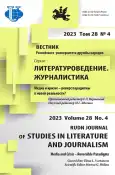Models and methods of controlled transgression of media in crisis conditions
- Authors: Zykov S.V.1, Babkin E.A.1, Ulitin B.I.1
-
Affiliations:
- HSE University
- Issue: Vol 28, No 4 (2023): Media and Crisis – Reversible Paradigms
- Pages: 749-756
- Section: JOURNALISM
- URL: https://journal-vniispk.ru/2312-9220/article/view/319110
- DOI: https://doi.org/10.22363/2312-9220-2023-28-4-749-756
- EDN: https://elibrary.ru/KRFKZD
- ID: 319110
Cite item
Full Text
Abstract
The creation and transgression of mediaobjects is a complicated process that involves making difficult decisions. Under such conditions, the risk of media crises inevitably increases, for example, inadequate perception by the reader of information released by the media, etc. To avoid such crises, it is necessary to take into account all possible factors, both quantitative and qualitative, characterizing mediaobjects and media in general, as well as precise evaluation methods. The focus of the study is on developing a new approach to decision-making that will aid in the controlled transgression of mediaobjects during crisis situations. The method for making decisions based on a hierarchy of cross-disciplinary criteria that takes into account the concept of crisisology is proposed. Additionally, the authors suggest the use of a decision support software service that utilizes an ontology-based mechanism to adopt the user interface dynamically. The proposed method is universal and can be applied to assess different types of medical objects, reducing the likelihood of crisis situations (caused, among other things, by incorrect assessment of the reliability of information).
Keywords
About the authors
Sergey V. Zykov
HSE University
Email: szykov@hse.ru
ORCID iD: 0000-0002-2115-5461
Doctor of Technical Sciences, Professor, Department of Business Informatics, Graduate School of Business
11 Pokrovskii Bulvar, Moscow, 109028, Russian FederationEduard A. Babkin
HSE University
Email: eababkin@hse.ru
ORCID iD: 0000-0003-2597-9043
PhD in Computer Science, Docent, Professor, Department of Information Systems and Technologies, Faculty of Informatics, Mathematics, and Computer Science
11 Pokrovskii Bulvar, Moscow, 109028, Russian FederationBoris I. Ulitin
HSE University
Author for correspondence.
Email: bulitin@hse.ru
ORCID iD: 0000-0003-3774-2457
PhD in Computer Science, Docent, Department of Information Systems and Technologies, Faculty of Informatics, Mathematics, and Computer Science
11 Pokrovskii Bulvar, Moscow, 109028, Russian FederationReferences
- Belousova, N.M. (2018). Evaluation of the competitiveness of a media project at different stages of its life cycle. Media Economics of 21st Century, (3), 18-23. (In Russ.)
- Cid-Lopez, A., Hornos, M.J., Carrasco, R.A., Herrera-Viedma, E., & Chiclana, F. (2017). Linguistic multi-criteria decision-making model with output variable expressive richness. Expert Systems with Applications, 83, 350-362. http://dx.doi.org/10.1016/j.eswa.2017.04.049
- Crawley, E., Cameron, B., & Selva, D. (2016). System architecture: Strategy and product development for complex systems. Pearson Education.
- Dehe, B., & Bamford, D. (2015). Development, test and comparison of two multiple criteria decision analysis (MCDA) models: A case of healthcare infrastructure location. Expert Systems with Applications, 42(19), 6717-6727. https://doi.org/10.1016/j.eswa.2015.04.059
- Demidovskij, A., & Babkin, E. (2022). Neural multigranular 2-tuple average operator in neural-symbolic decision support systems. Proceedings of the Fifth International Scientific Conference “Intelligent Information Technologies for Industry” (pp. 350-359). Cham: Springer. https://doi.org/10.1007/978-3-030-87178-9_35
- Herrera, F., & Martinez, L. (2001). A model based on linguistic 2-tuples for dealing with multigranular hierarchical linguistic contexts in multi-expert decision-making. IEEE Transactions on Systems, Man, and Cybernetics, Part B (Cybernetics), 31(2), 227-234. https://doi.org/10.1109/3477.915345
- Igoulalene, I., Benyoucef, L., & Tiwari, M.K. (2015). Novel fuzzy hybrid multi-criteria group decision making approaches for the strategic supplier selection problem. Expert Systems with Applications, 42(7), 3342-3356. https://doi.org/10.1016/j.eswa.2014.12.014
- Martínez, L., Rodriguez, R.M., & Herrera, F. (2015). The 2-tuple linguistic model computing with words in decision making (pp. 1-21). Cham: Springer. https://doi.org/10.1007/978-3-319-24714-4
- Senthil, S., Srirangacharyulu, B., & Ramesh, A. (2014). A robust hybrid multi-criteria decision-making methodology for contractor evaluation and selection in third-party reverse logistics. Expert Systems with Applications, 41(1), 50-58. https://doi.org/10.1016/j.eswa.2013.07.010
- Xu, Z. (2004). A method based on linguistic aggregation operators for group decision making with linguistic preference relations. Information Sciences, 166(1-4), 19-30. https://doi.org/10.1016/j.ins.2003.10.006
- Zykov, S.V. (2021). IT crisisology: Smart crisis management in software engineering: Models, methods, patterns, practices, case studies. Singapore: Springer. https://doi.org/10.1007/978-981-33-4435-8
Supplementary files









